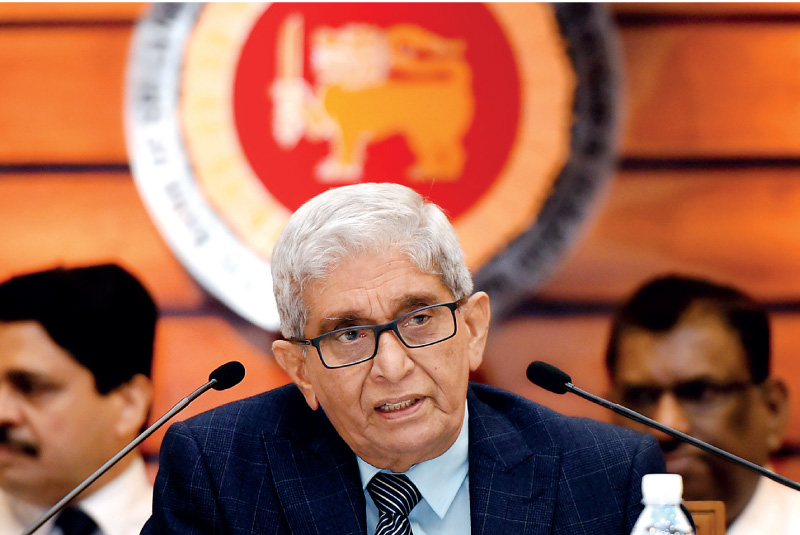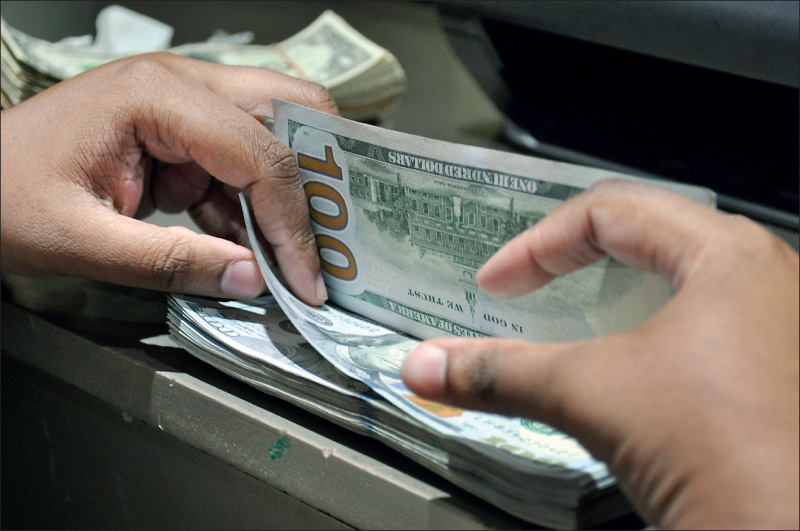Monday Apr 28, 2025
Monday Apr 28, 2025
Monday, 5 July 2021 01:26 - - {{hitsCtrl.values.hits}}

This is not the first time Governor Lakshman has blamed market participants for the continuous downturn in the economy
 Plea for calmness in national interest
Plea for calmness in national interest
In the wake of Sri Lanka’s foreign exchange crisis graduating from ‘acute’ to ‘severely acute’, the Central Bank Governor Deshamanya Professor W.D. Lakshman has appealed for calmness which everyone should do in his view in national interest (available at: https://www.cbsl.gov.lk/en/news/statement-by-governor-on-foreign-currency-liquidity-in-domestic-market).
Reiterating the Government’s commitment to meet all foreign exchange liabilities on time, he has blamed the speculators, political elements, and the media for the current mishap: “We have also observed that some segments of the Sri Lankan community motivated by political reasons have continued to fuel adverse speculation about the future path of the exchange rate and the ability of the Government to service its obligations. Such self-serving speculations are unwarranted and are harmful to the general public as well as to the business community themselves.
“These speculative comments have naturally created some unnecessary short-term imbalance in the foreign exchange market between inflows and outflows. However, it must be noted that the Government and the Central Bank have ensured that trade is not unduly disrupted, and intermediate and capital goods imports are given priority in the process of imports. Total import values have remained considerably high at a monthly average of $ 1.7 billion during March, April and May 2021. High import values in these months show that importers, particularly of essential goods, have not been overly inconvenienced as the published media reports claim.”
Practice of blaming others for the mishaps in the economy
This is not the first time Governor Lakshman has blamed market participants for the continuous downturn in the economy. Calling critics as purveyors of doom and gloom who do not understand the alternative economic policy being pursued by the Government of President Gotabaya Rajapaksa, he had confidently said that the Government had the economy well in hand (available at: http://www.ft.lk/front-page/Govt-managing-economy-using-alternative-measures-CB-Chief/44-713143). The fallacy in his charge was presented by this writer in an article in this series (available at: https://www.ft.lk/opinion/Critics-failing-to-understand-alternative-strategy-are-purveyors-of-doom-and-gloom-CB-Governor/14-713149).
Market going in panic mode defies CB fixed rates
After his plea for calmness, the market became chaotic and panic. When commercial banks had failed to meet the customers’ demand for foreign currency at the exchange rates announced by the Central Bank, a parallel curb market had sprung up to fill the vacuum. The exchange rate announced by the Central Bank was Rs. 202 per US dollar. But in the curb market it went up to Rs. 215 to 220 per US dollar defying the intention of the Bank to maintain the rate at the low level (available at: https://economynext.com/sri-lanka-rupee-dollar-parallel-markets-step-in-amid-money-printing-forex-curbs-83510/#modal-one).
A day later, it is reported that it has fallen to Rs. 225 to 226 level and still there are no sellers dollars in the black market at those rates (available at: https://economynext.com/sri-lanka-rupee-quoted-at-225-226-50-to-us-dollar-in-kerb-market-amid-money-printing-83579/). Markets do not act in national interest as Governor Lakshman has wished. They would act in collective market interest wiping out losses and gains and eventually reaching a new market position which economists call ‘market equilibrium’. The role of the Central Bank is to facilitate this process by conducting prudent policies. Hence, plea for acting in national interest cannot substitute prudent policy stances.
 Crisis is not unexpected
Crisis is not unexpected
The present severely acute crisis was not totally unanticipated. It was a gradual deterioration from around 2013 and independent economic analysts had warned the governments in power about its dire consequences. This writer in an article in this series warned the new President Gotabaya Rajapaksa about the impending external sector crisis as follows: “As revealed by the Central Bank statistics, in the next 12-month period, the total foreign debt servicing commitments comprising both the repayment of the principal and the payment of interest will amount to $ 6 billion. This is made up of the Government’s commitments amounting to $ 4.8 billion and those of the private sector by about $ 1.2 billion.
“The country’s liquid foreign exchange balances after taking out the illiquid gold reserves at end-November 2019 had been some $ 6.5 billion and if it is used for debt payments, its foreign exchange reserves would fall to a critically low level. Thus, Gota’s problem is slightly different from those of the private sector borrowers.”
“The latter may be having rupee funds to meet its commitments and its problem is lack dollars in the country. Gota’s problem is that he has neither rupees nor dollars to do so. Hence, he has no alternative but to borrow abroad to fill his coffers and use those proceeds to repay his loan commitments. This strategy, known as loan recycling and used by all the previous successive governments, would provide only a temporary solution to the country. It adds to Gota’s, woes and, if continued unabated, those of any future administration to come to power as well” (available at: https://www.ft.lk/columns/Gota-s-economic-war-Ferocity-of-the-enemy-makes-the-challenge-frightening/4-693054).
Money printing by following MMT philosophy
However, instead of heeding to this warning, the Government and the Central Bank continued with the adoption of the prescribed by a breakaway economic school calling itself Modern Monetary Theorists. In terms of this policy stance, there is nothing wrong in financing the Government budget by getting the banking sector to create new money, known as money printing in common parlance, because that new money by increasing the total demand in the economy will pave way for economic prosperity.
Accordingly, the total money stock in the country which the Central Bank defines as M2b increased during December 2019 and May 2021 by Rs. 2,409 billion or 32% from Rs. 7,624 billion to Rs. 10,033 billion. The Government’s borrowing from the banking sector during this period exceeded this growth and it amounted to Rs. 2,683 billion. This number was made up of Rs. 693 billion by the Central Bank and Rs. 1,993 billion by commercial banks. Hence, the Government was wholly responsible for the total money creation in the economy during this period. This is Modern Monetary Theory at work. The risk of following this theory was analysed by this writer in a series of articles by this writer and the latest available at https://www.ft.lk/columns/Following-MMT-Should-Sri-Lanka-rely-on-inflation-tax-to-generate-income-for-cash-strapped-Govt/4-713565.
Stabilising the exchange rate through arm-twisting methods
Now there is no escape and this excessive creation of money has caused the country’s foreign reserves to fall putting pressure on the exchange rate to depreciate in the market. The Central Bank on its side sought to hold on to the exchange rate by supplying dollars from the country’s foreign reserves to the market. When this was no longer possible, it tried to adopt an unconventional tactic that could be called ‘immoral suasion’ or arm-twisting of the forex dealers in commercial banks.
Accordingly, banks had to keep their selling rate of dollars at Rs. 202 per US dollar. This gave rise to panic in the market and the much-maligned speculation on the exchange rate by some market participants. After sowing the seeds for speculation, it is now unwarranted for the Central Bank to blame the speculators.
Decline in foreign reserves
The result has been a sharp decline in the foreign reserves of the country. At end 2019, the usable official foreign reserves after adjusting for the gold balance amounted to $ 7 billion. This has fallen to $ 3.6 billion at end May 2021. Given an import bill of $ 18 billion during the next 12-month period, this is sufficient to finance only 2.4 months of imports of the country. Accordingly, the usable official foreign reserves have fallen to a critically low level today.
The Central Bank expects to boost these reserves by adopting two strategies. One is going for some temporary arrangements with China, India, and Bangladesh by exchanging Sri Lanka rupees for Chinese Yuan in the case of China and for dollars in the case of India and Bangladesh, an arrangement known as a SWAP facility. The other is getting some $ 800 million from the International Monetary Fund or IMF when it makes a new allocation of its book currency called Special Drawing Rights or SDRs.
This plan of boosting reserves could not convince the market participants, and the result was the overnight development of a curb market with a high exchange rate at around Rs. 225 and Rs. 226 per US dollar.
Previous occasions in which Sri Lanka was bailed out by IMF
There had been two previous occasions when Sri Lanka’s foreign reserves had fallen to such critically low levels. One was in 1988 when the country had been at the height of the JVP insurrection. The other was in 2008 when the war with LTTE has escalated to a point of no return. On both occasions, Sri Lanka was rescued by IMF and the lessons learned from those exercises could be a guidance to Governor Lakshman.
Bailout in 1988
In 1988, Sri Lanka’s foreign reserves fell to $ 277 million which was sufficient for financing only 1.2 months of the imports of the country for the next 12 months. Governor Warnasena Rasaputra, supported by Treasury Secretary W.M. Thilakaratna and coordinated by Sri Lanka’s Alternative Executive Director at the Fund A.S. Jayawardena, went for a Structural Adjustment Facility of SDR 156 million with IMF. It was a tough negotiation for Governor Rasaputra who had served as Sri Lanka’s Alternative Executive Director at the Fund before he became the Governor in 1978.
All resources in the Economic Research Department of the Central Bank were directed toward this exercise. I recall participating in these negotiations as the Deputy Director of the Department, guided by its Director Wimal Hettiarachchi. It was a back-and-forth negotiation agreeing and disagreeing and finally coming to a consensus. IMF approved the facility in March that year and Sri Lanka made the first drawing toward the end of the year. This facility created confidence in Sri Lanka among the foreign investors, and from 1990 onward, the country was able to record surpluses in the balance of payments adding to its foreign reserves. A catastrophe was thus avoided by the timely action of Governor Rasaputra.
Multipronged approach in 2008
In 2008, foreign reserves fell to $ 2,560 million which was sufficient to finance only two months of the estimated imports of the country for the next 12 months. The country was at war and the armed forces were fighting it in the field. Quite different from this war, there was a separate financial war being fought by Governor Ajith Nivard Cabraal and Treasury Secretary Sumith Abeysinghe.
That war involved securing the necessary foreign exchange to pay for weapons being used by armed forces which were in the fields. China had supplied weapons to Sri Lanka on three months’ credit. The Bank of Ceylon which had opened letters of credit or LCs on behalf of the Ministry of Defence had to meet the LC obligations once the bills matured. For that, the Central Bank had to provide foreign exchange to BOC, but it did not have enough foreign exchange in its reserves.
A strenuous road show
I recall Governor Cabraal making several initiatives to bolster the depleting foreign exchange reserves. One was to make Sri Lanka’s maiden International Sovereign Bond or ISB issue of $ 500 million. Since it was Sri Lanka’s first-time entry to ISB market, the country had to conduct a series of road shows in major international financial centres to lure prospective investors. Governor Cabraal led a team of high officials consisting of those from the Central Bank, Ministry of Finance, People’s Bank and the Bank of Ceylon and visited financial centres like Singapore, Hong Kong, Tokyo, Frankfurt, London, New York and Los Angeles. Altogether he addressed close to 50 road show meetings and the exercise was a success.
The other was to send teams of Central Bank officers to visit main countries in which Sri Lankan Diaspora was living to coax them to invest in Sri Lanka government securities in foreign currencies. Accordingly, different teams were sent to the Middle East, Europe, London, USA and Oceania. I led the team that visited this last place, Oceania. We met Sri Lankan Diaspora in Melbourne, Sydney, Canberra, and Wellington. But these missions were not a success since Sri Lankan Diaspora was not so patriotic as Governor Cabraal had expected.
Bailout by IMF
In these circumstances, the only source for Sri Lanka was IMF. Governor Cabraal supported by Treasury Secretary Sumith Abeysinghe and coordinated by Dharma Dheerasinghe from the Fund started negotiations with IMF. There were hiccups in the process. When things began to fall into the right path, IMF was hesitant in approving the facility. I recall India coming to Sri Lanka’s help at that point. Indian Finance Minister Pranab Mukerji who was the Governor of the IMF’s Board of Governors representing the Constituency that included Sri Lanka gave an ultimatum to the Fund. He declared that if IMF did not approve of this facility, India would provide these funds to Sri Lanka. It did the trick and IMF approved of an Extended Credit Facility of SDR 1,653 million for Sri Lanka in September 2009. This action boosted the country’s foreign reserves to $ 5,357 million by end 2009 and $ 7,197 million a year later.
Need for saner action
It is the responsibility of the Monetary Board to protect the rupee domestically and internationally. On previous occasions, the Board stood valiantly to perform this duty by being flexible in its stance. As I have reported above, even the Treasury secretaries who are Government officials supported these prudent policies fully. There are three independent board members who represent people and not the Government. They have a duty by the nation to perform. If they fail, there is an irrecoverable loss to Sri Lanka rupee.
The above episodes have been related to emphasise that the present crisis is not the only occasion where Sri Lanka had undergone such crises. On both occasions, the respective Governors did not appeal to the sentiments of national interest of people but took concrete action to face the problem head on. I hope this would serve as a learning experience for all those who are at the top of the Central Bank today.

(The writer, a former Deputy Governor of the Central Bank of Sri Lanka, can be reached at [email protected].)
Discover Kapruka, the leading online shopping platform in Sri Lanka, where you can conveniently send Gifts and Flowers to your loved ones for any event including Valentine ’s Day. Explore a wide range of popular Shopping Categories on Kapruka, including Toys, Groceries, Electronics, Birthday Cakes, Fruits, Chocolates, Flower Bouquets, Clothing, Watches, Lingerie, Gift Sets and Jewellery. Also if you’re interested in selling with Kapruka, Partner Central by Kapruka is the best solution to start with. Moreover, through Kapruka Global Shop, you can also enjoy the convenience of purchasing products from renowned platforms like Amazon and eBay and have them delivered to Sri Lanka.
Discover Kapruka, the leading online shopping platform in Sri Lanka, where you can conveniently send Gifts and Flowers to your loved ones for any event including Valentine ’s Day. Explore a wide range of popular Shopping Categories on Kapruka, including Toys, Groceries, Electronics, Birthday Cakes, Fruits, Chocolates, Flower Bouquets, Clothing, Watches, Lingerie, Gift Sets and Jewellery. Also if you’re interested in selling with Kapruka, Partner Central by Kapruka is the best solution to start with. Moreover, through Kapruka Global Shop, you can also enjoy the convenience of purchasing products from renowned platforms like Amazon and eBay and have them delivered to Sri Lanka.